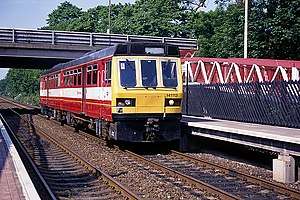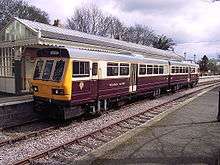British Rail Class 141
The British Rail Class 141 was the first production model of the Pacer diesel multiple units. Its lifespan in the UK was 13 years: some units were exported to Iran operating for 8 years, for a total lifespan of 21 years.
| British Rail Class 141 Pacer | |
|---|---|
 141 113 at Pontefract Tanshelf in 1996 | |
Interior of a Class 141. | |
| In service | 1984 - 2005 |
| Manufacturer | British Leyland |
| Order no. |
|
| Family name | Pacer |
| Constructed | 1984 [2] |
| Refurbished | 1988 - 1989 |
| Number built | 20 units |
| Number in service | 14 units (exported) |
| Number preserved | 2 units |
| Number scrapped | 4 units |
| Formation |
|
| Diagram |
|
| Fleet numbers | |
| Capacity |
|
| Operator(s) |
|
| Depot(s) | Neville Hill[1] |
| Line(s) served | West Yorkshire |
| Specifications | |
| Car body construction | Steel[5] |
| Car length | 15.45 m (50 ft 8 1⁄4 in)[4] |
| Width | 2.5 m (8 ft 2 3⁄8 in)[4] |
| Height | 3.906 m (12 ft 9 3⁄4 in)[5] |
| Articulated sections | 2 |
| Wheelbase | 9 m (29 ft 6 3⁄8 in)[5] |
| Maximum speed | 75 mph (121 km/h)[3] |
| Weight |
|
| Prime mover(s) | 1 × Leyland TL11[3] |
| Power output | 205 hp (153 kW)[4] |
| Transmission | SCGR500 4-speed[3] |
| Train heating |
|
| Bogies | AX1[5] |
| Braking system(s) | Air[5] |
| Safety system(s) | AWS |
| Coupling system | |
| Track gauge | 1,435 mm (4 ft 8 1⁄2 in) standard gauge |
Description
In the early 1980s British Rail were looking to replace the remaining 1950s first generation diesel multiple units on lightly used branch lines. Financial pressures precluded them ordering more heavyweight second generation units (the business case could not be made to balance) so were looking for a cheaper alternative.
British Rail engineers looked at the Leyland National bus, then in widespread usage, with its modular design as a basis for the design. Several single and two car prototypes were built before an order was placed with Leyland Bus for twenty class 141 two car units in 1984.
The units were notoriously unreliable, but reliability improved when the units were modified by Hunslet-Barclay between 1988 and 1989. At the same time the buckeye couplings were replaced with the BSI type fitted to the later Class 142, for more flexible working.
Both axles (one driving per coach at the inner end) were fitted directly to the chassis rather than being mounted on bogies, leading to a rather rough ride especially over pointwork. Because of this, the units were generally less popular with passengers.
The units were based mainly in and across West Yorkshire on routes radiating from Leeds, where they worked up until 1997 when they were replaced by Class 142. They were sponsored by West Yorkshire Passenger Transport Executive, and were initially painted in the PTE's Verona green and buttermilk livery with "MetroTrain" branding, later receiving the red and cream "Metro-Train" livery.
The units were numbered from 141001 to 141020. After modification they became 141101 to 141120, although not in order, since the opportunity was taken to match the final digits of the unit numbers with those of the vehicle numbers.
Overseas
In 1984, a Class 141 unit was built for trial running in Malaysia and Thailand. The unit was re-gauged to metre gauge. The trial running wasn't successful.[6] The vehicle was different from the twenty British trains having only longitudinal seating for 120 passengers and space for another 140 standing. Only 1 car was powered with the other being a trailer vehicle. After the unsuccessful trial in Thailand the Pacer went to Malaysia and then to Indonesia for further evaluation. It was last seen outside the Ulu Yam station, on a railway siding, in Malaysia in fairly derelict condition in 2000.
At the end of their career with British Rail, 12 units were sold to Islamic Republic of Iran Railways and were exported during 2001/2002.[7][8] with two spotted in service in 2005,[9] All units have since been withdrawn and replaced by new DMUs. Two units (106 & 112) were exported to the Netherlands, but they were scrapped in 2005. Some units remain in the United Kingdom with two units in preservation: 141108 at the Colne Valley Railway, and 141113 at the Midland Railway – Butterley. Two units (141103 and 141110) were formerly preserved at the Weardale Railway, of which 141103 and the one remaining car from 141110 were scrapped in March 2018.[10]
Unit details
| Key: | Preserved | Exported | Scrapped |
|---|
| Set Number (as built) | Set Number (following modifications) | Vehicle Number (1) | Vehicle Number (2) | Status | Current location | Comments |
|---|---|---|---|---|---|---|
| 141 001 | 141 102 | 55502 | 55522 | Exported | Iran | - |
| 141 002 | 141 103 | 55503 | 55523 | Scrapped | Scrapped | Formerly preserved on Weardale Railway. Scrapped in 2018. |
| 141 003 | 141 104 | 55504 | 55524 | Scrapped | Scrapped | 141104 was involved in a head-on collision with a Class 156 Sprinter (156476) at Huddersfield at around 10pm on 6 November 1989. 33 people were injured, 3 seriously. The railbus was withdrawn and scrapped in 1989. 156476 was returned to service after repairs that lasted until March 1990. It was repaired at BRML Doncaster and was transferred to Haymarket upon release. |
| 141 004 | 141 105 | 55505 | 55525 | Exported | Iran | - |
| 141 005 | 141 106 | 55506 | 55526 | Exported | Netherlands | Last known whereabouts were at Moerdijk in August 2005, along with 141112.[11] |
| 141 006 | 141 107 | 55507 | 55527 | Exported | Iran | - |
| 141 007 | 141 108 | 55508 | 55528 | Preserved | Eastleigh TMD | Stored following sale of unit |
| 141 008 | 141 109 | 55509 | 55529 | Exported | Iran | - |
| 141 009 | 141 110 | 55510 | 55530 | Scrapped | Weardale Railway | |
| 141 010 | 141 111 | 55511 | 55531 | Exported | Iran | - |
| 141 011 | 141 112 | 55512 | 55532 | Exported | Netherlands | Last known whereabouts were at Moerdijk in August 2005, along with 141106.[11] |
| 141 012 | 141 113 | 55513 | 55533 | Preserved | Midland Railway – Butterley | Unit fitted with Cummins L10 engines and Voith hydraulic transmission. Owned by the Llangollen Railcar Group, though usually based at the Midland Railway – Butterley. |
| 141 013 | 141 114 | 55514 | 55534 | Exported | Iran | - |
| 141 014 | 141115 | 55515 | 55535 | Exported | Iran | - |
| 141 015 | 141116 | 55516 | 55536 | Exported | Iran | - |
| 141 016 | 141117 | 55517 | 55537 | Exported | Iran | - |
| 141 017 | 141118 | 55518 | 55538 | Exported | Iran | Was named Flower when owned by SERCO as the weedkiller unit. |
| 141 018 | 141119 | 55519 | 55539 | Exported | Iran | - |
| 141 019 | 141120 | 55520 | 55540 | Exported | Iran | - |
| 141 020 | 141 101 | 55521 | 55541 | Scrapped | Scrapped | Scrapped in 2004. |
Non-passenger use
Unit number 141118 was modified for use as a weedkilling unit by Serco. It gained a grey and red livery and black wrap-around window surrounds. It was among the units later exported to Iran. A photograph of this unit, in SERCO livery, at Huddersfield is shown on page 36 of Modern Locomotives Illustrated - August/September 2012.
Images
- 141113 standing at Swanwick shed, Midland Railway - Butterley
 141103 standing at Stanhope station, Weardale Railway
141103 standing at Stanhope station, Weardale Railway- Driver's cab of unit 141103
- 141108 at the Colne Valley Railway
 Unidentified class 141 unit in original West Yorkshire PTE Verona green and buttermilk livery
Unidentified class 141 unit in original West Yorkshire PTE Verona green and buttermilk livery
References
- Fox & Hughes 1994, p. 15
- "Class 141 Railbus Built 1984". Llangollen Railcar Group. Archived from the original on 27 August 2008.
- "Class 141". The Railway Centre. Archived from the original on 9 March 2005.
- Fox 1987, p. 40
- Vehicle Diagram Book No. 220 for Diesel Multiple Unit Trains (Railcars) (PDF). Barrowmore MRG. Derby: British Railways Board. 1982. DP228, DP229.
- "The Leyland Experimental Vehicle". Traintesting.com. Retrieved 2 December 2015.
- "Rolling Stock of Iranian Railways". Rah Ahan Iran. Archived from the original on 28 September 2011.
- "Rolling Stock of Iranian Railways". Rah Ahan Iran. Archived from the original on 6 July 2011.
- http://www.phantasrail.com/Iran/130%202005.10.09%20Teheranu.jpg
- Railway Magazine May 2018 p. 90
- Railways Illustrated: 34. November 2005. Missing or empty
|title=(help)
Sources
- Fox, Peter (1987). Multiple Unit Pocket Book. British Railways Pocket Book No.2 (Summer/Autumn 1987 ed.). Platform 5 Publishing Ltd. ISBN 0906579740. OCLC 613347580.CS1 maint: ref=harv (link)
- Fox, Peter; Hughes, Barry (1994). DMUs & Channel Tunnel Stock. British Railways Pocket Book No.3 (7th ed.). Platform 5. ISBN 9781872524597.CS1 maint: ref=harv (link)
Further reading
External links
| Wikimedia Commons has media related to British Rail Class 141. |